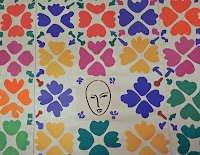While reviewing my note books, I found twenty six pages written about the exhibition L'Art en Guerre at the Musée d'Art Moderne de la Ville de Paris. Closed in February, it is now on view at the Guggenheim in Bilbao till September. The scope of the exhibition which assembles a large amount of material including not only rarely seen or previously unseen paintings, drawings, sculptures but also documents, posters, hand written notes, diaries...goes well beyond art.
 Starting with the opening day of the first international surrealist retrospective at the "galerie des Beaux-Arts", January 17, 1938, the exhibition gives a review of the art created in France till the onset of the Cold War, covering almost ten years reflected in four hundred works from one hundred artists, some well-known, others anonymous. It tells the story of the shattered artists' lives, interned in French camps, exiled or hiding in clandestinity and its influence on their creativity and how their fate during that tragic period shaped the art in France.
Starting with the opening day of the first international surrealist retrospective at the "galerie des Beaux-Arts", January 17, 1938, the exhibition gives a review of the art created in France till the onset of the Cold War, covering almost ten years reflected in four hundred works from one hundred artists, some well-known, others anonymous. It tells the story of the shattered artists' lives, interned in French camps, exiled or hiding in clandestinity and its influence on their creativity and how their fate during that tragic period shaped the art in France.Works from Surrealist artists, well-known (Duchamp, Tanguy, Dali, Eluard, De Chirico...) or less-known (Delvaux, Denise Bellon...) and series of "Cadavres Exquis" from 1931 signed by artists like Breton, Sadoul, Eluard, Man Ray, Tzara are representing the pre-war period. Escapades from reality, humor, cynicism, they are facing rarely seen pieces made in captivity by Max Ernst, Bellmer, Wols, interned in camps in the South of France, or Freundlich who died in deportation.
A list of the artists and their works would be fastidious and pointless. The curators organized mini exhibitions to show well-known artists ( Picasso, Matisse) or movements (religious art, art brut), while presenting lesser artists in the context of the time with numerous documents, photographs, posters, providing a thread to the main exhibition.
Picasso remained in Paris during "l'Occupation" and kept working in his Left Bank atelier where he had painted Guernica. Ostracized by the Nazi regime, he kept a low profile and most of his production became public after the war. Matisse also well represented with paintings and famous cutouts, was in the South of France and had to deal with the arrest of his daughter by the Gestapo. Elderly and in fragile health, he kept a daily work schedule and published Jazz in 1947.
The art in France reflected a divided country with artists like de Vlaminck, Van Dongen, Derain, de Segonzac collaborating with the Vichy government and the German occupiers, artists who chose to stay in Paris, working in the shadow like Picasso or artists who took refuge in the South like Matisse, Bonnard, Rouault. Others like Chagall fled Europe for the United States.
In Paris, attempts to "art as usual" punctuated the war time with events like the exhibition at the gallery Braun in 1941 which introduced the "Jeunes peintres de Tradition Française", the opening of the "Musée d'Art Moderne" in 1942 or the exhibition at the "Galerie de France" in 1943. But freedom of creativity was thwarted by the Vichy regime headed by the Nazis, which denounced degenerate art and promoted a return to "real art" (banned abstract, encouraged the use patriotic colors and themes centered on family, work...).
Few artists like the Alsacian Joseph Steib were discovered after the war. His satiric colorful paintings denouncing Nazism and Hitler were realized in his kitchen and exposed once in his town hall under the name The Salon of Dreams.
But many artists did not return from the camps and left only few works to remember them like Myriam Levy, Charlotte Salomon, Nussbaum and some stayed anonymous. For them, art became a mean to escape the reality of the camps and they unleashed their creativity on any material they could spare: matchboxes, cans, cardboard boxes, fabric. If sometimes technically weak, the pieces are of great historical interest and the poignant memories left from the camps are emotionally overwhelming.
In contrast, the story of the gallery Bucher, a safe heaven for artists is heartwarming. Her director, Jeanne Bucher who ran her gallery discreetly during the war, brought the outside world to Paris, promoting works from "avant-garde" artists like Paul Klee, Wassily Kandinsky, Robert Motherwell, Nicolas de Staël.
A following outstanding display is devoted to religious art, art brut and primitivism spearheaded by Dubuffet during the period following the war but it feels off the subject.
The exhibition is the occasion to remember a history which is still haunting France. The art world changed after the devastating war and artists discovered the United States, abstract expressionism followed by minimalism.
no photographs allowed at the exhibition
photographs by the author:
"The Look of Amber", Yves Tanguy, 1929
Detail of a Cutout from Matisse
Wikimedia
"Guernica", Picasso, 1937



No comments:
Post a Comment